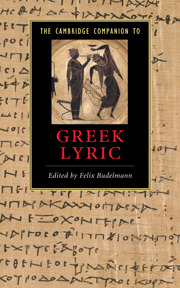Book contents
- Frontmatter
- Introducing Greek lyric
- Part I: Contexts and topics
- 1 Genre, occasion and performance
- 2 Greek lyric and the politics and sociologies of archaic and classical Greek communities
- 3 Greek lyric and gender
- 4 Greek lyric and the place of humans in the world
- 5 Greek lyric and early Greek literary history
- 6 Language and pragmatics
- 7 Metre and music
- Part II: Poets and traditions
- Part III: Reception
- Chronology of select melic, elegiac and iambic poets
- Further Reading
- Glossary
- List of works cited
- Index
6 - Language and pragmatics
from Part I: - Contexts and topics
Published online by Cambridge University Press: 28 May 2010
- Frontmatter
- Introducing Greek lyric
- Part I: Contexts and topics
- 1 Genre, occasion and performance
- 2 Greek lyric and the politics and sociologies of archaic and classical Greek communities
- 3 Greek lyric and gender
- 4 Greek lyric and the place of humans in the world
- 5 Greek lyric and early Greek literary history
- 6 Language and pragmatics
- 7 Metre and music
- Part II: Poets and traditions
- Part III: Reception
- Chronology of select melic, elegiac and iambic poets
- Further Reading
- Glossary
- List of works cited
- Index
Summary
Introduction
The label 'lyric' applies in modern times to a heterogeneous group of Greek texts, which includes the songs originally performed by an ensemble of singers and dancers, those sung by soloists and the recitative poems, which were accompanied by the music of the aulos at banquets and on other occasions. These various categories of poems do share, however, important formal features. Greek 'lyric' and 'epic' poetry were both meant for oral performance in various contexts but, in contrast to the heroic tales narrated in the epic hexametric poems, lyric poems entail the possibility of an explicit textual interaction with an audience, which is often mentioned and sometimes addressed: they seem to work as part of a communication process, the context of which later readers usually have to extract from the texts themselves. It would be tempting to read these poems as the transcript of an actual face-to face interaction. From many points of view, however, they are set off from a normal, unmarked context of oral communication: to start with, they were arranged in accordance with a metrical pattern and were performed with a musical accompaniment, two features which distinguished them from normal face-to face conversation. Several other linguistic (lexical, morphological and syntactical) traits also distinguish lyric from other kinds of unmarked speech situations, as we shall see very briefly in the second part of this chapter. A further, important difference, which is the subject of the first part of the chapter, is that the interaction with extra-textual entities inscribed in these texts, such as the address to an audience, the reference to spatial and temporal coordinates and, more broadly speaking, their 'pragmatics', work in ways that diverge from those of ordinary face-to-face communication.
- Type
- Chapter
- Information
- The Cambridge Companion to Greek Lyric , pp. 114 - 129Publisher: Cambridge University PressPrint publication year: 2009
- 6
- Cited by



